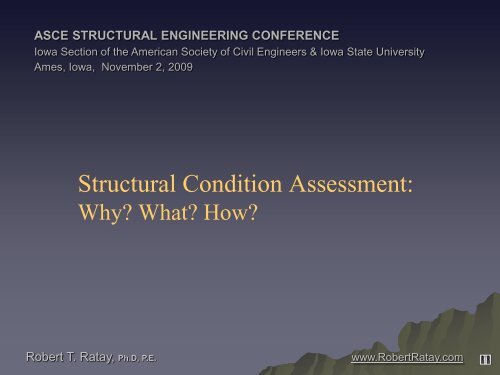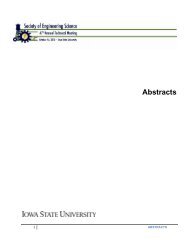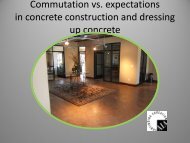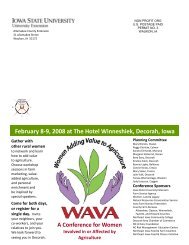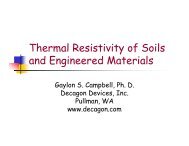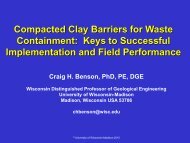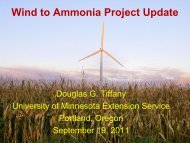Structural Condition Assessment: - Conference Planning and ...
Structural Condition Assessment: - Conference Planning and ...
Structural Condition Assessment: - Conference Planning and ...
Create successful ePaper yourself
Turn your PDF publications into a flip-book with our unique Google optimized e-Paper software.
ASCE STRUCTURAL ENGINEERING CONFERENCE<br />
Iowa Section of the American Society of Civil Engineers & Iowa State University<br />
Ames, Iowa, November 2, 2009<br />
<strong>Structural</strong> <strong>Condition</strong> <strong>Assessment</strong>:<br />
Why? What? How?<br />
Robert T. Ratay, Ph.D, P.E.<br />
www.RobertRatay.com
O U T L I N E<br />
Part I<br />
Overview<br />
Why condition assessment?<br />
What can be wrong?<br />
What is structural condition<br />
assessment?<br />
Types of condition assessment<br />
Qualifications<br />
Codes, St<strong>and</strong>ards, Guides<br />
References<br />
Part II<br />
Practice <strong>and</strong> business<br />
The call<br />
Assurance of public safety<br />
Inspection & documentation<br />
– Team<br />
– Field equipment<br />
– Field activities<br />
– Field documentation<br />
Preliminary conclusions<br />
Report(s)
O U T L I N E<br />
Part I<br />
Overview<br />
Why condition assessment?<br />
What can be wrong?<br />
What is structural condition<br />
assessment?<br />
Types of condition assessment<br />
Qualifications<br />
Codes, St<strong>and</strong>ards, Guides<br />
References<br />
Part II<br />
Practice <strong>and</strong> business<br />
The call<br />
Assurance of public safety<br />
Inspection & documentation<br />
– Team<br />
– Field equipment<br />
– Field activities<br />
– Field documentation<br />
Preliminary conclusions<br />
Report(s)
.<br />
Part I<br />
Overview
Somewhat like people<br />
Structures, like people,<br />
– get older<br />
– need check-ups<br />
– get sick<br />
– need treatment when ill<br />
– may even be placed on life-support
Somewhat like people<br />
Structures, like people, can maintain their good<br />
health with age<br />
– if properly cared for<br />
– examined<br />
– treated when needed
Why condition assessment?<br />
To examine <strong>and</strong> diagnose for<br />
– sale <strong>and</strong> purchase of buildings<br />
– needed maintenance<br />
– repair <strong>and</strong> rehabilitation<br />
– adaptive reuse of facilities<br />
– retrofitting for ever-changing code compliance<br />
– increased physical security
Defect<br />
What can be wrong?<br />
– errors in design, poor construction, defective materials<br />
Deterioration<br />
– degradation in performance with time<br />
Damage<br />
– natural, deliberate or accidental event
What can be wrong?<br />
All structures deteriorate with time as the result of<br />
– repeated loadings<br />
– exposure to the elements<br />
– aging of materials<br />
– wear-<strong>and</strong>-tear<br />
– abuse<br />
– inadequate maintenance<br />
– other reasons
What can be wrong?<br />
Structures may also be unwell on account of<br />
– errors in their original design<br />
– shortcomings in their construction, or<br />
– imperfections in their materials
What is structural condition assessment?<br />
<strong>Structural</strong> condition assessment is the physical<br />
examination <strong>and</strong> diagnosis of the “health” of a<br />
structure<br />
It may include one, several, or all of the activities of<br />
– visual observation<br />
– measuring<br />
– photographing<br />
– probing <strong>and</strong> sampling<br />
– field <strong>and</strong> laboratory testing<br />
– numerical analyses<br />
– record keeping<br />
– documentation<br />
– report preparation
Types of condition assessment<br />
Walk-through<br />
Due-diligence<br />
<strong>Structural</strong> integrity / in-depth
Types of condition assessment<br />
Walk-through – walking through the facility, observing<br />
what is readily visible, <strong>and</strong> opining on the general<br />
condition of the facility.<br />
Due-diligence assessment – in essence, a cursory visual<br />
inspection of the facility, looking for <strong>and</strong> identifying<br />
clearly visible deficiencies, <strong>and</strong> reporting on the overall<br />
condition with a list of the obvious existing <strong>and</strong> potential<br />
problems, if any.<br />
It may be followed by a more thorough examination of parts or all of the<br />
structure.<br />
<strong>Structural</strong> integrity assessment – an in-depth examination<br />
of the facility including some or all of the following<br />
activities<br />
– visual observation<br />
– field measuring, photographing, probing <strong>and</strong> sampling<br />
– field <strong>and</strong> laboratory testing, numerical analyses<br />
– checking code-compliance<br />
– documentation<br />
– report preparation
Qualifications<br />
Underst<strong>and</strong>ing of structural behavior, <strong>and</strong> working<br />
knowledge of structural analysis <strong>and</strong> design<br />
Experience in field observation of structural<br />
problems<br />
Thoroughness in field measurements, testing <strong>and</strong><br />
analyses<br />
BUT ability to interpret data <strong>and</strong> make engineering<br />
judgment to convert them into valid conclusions <strong>and</strong><br />
recommendations are most important
Qualifications<br />
The engineer who undertakes condition assessment<br />
of a structure needs to know<br />
– how to plan <strong>and</strong> organize the process<br />
– how to inspect the structure<br />
– what to look for<br />
– how to recognize various conditions<br />
– what methods of field examination, laboratory testing,<br />
analytical evaluations are available, feasible <strong>and</strong> useful<br />
– what to recommend<br />
– how to report the findings
Practice <strong>and</strong> business<br />
Professional practice within the field of structural<br />
engineering<br />
A more-<strong>and</strong>-more active business
ASCE Guides<br />
Codes <strong>and</strong> St<strong>and</strong>ards<br />
ASTM St<strong>and</strong>ards<br />
International Existing Building Code
ASCE <strong>Condition</strong> <strong>Assessment</strong> Guidelines<br />
SEI/ASCE 11-99, Guideline for <strong>Structural</strong> <strong>Condition</strong><br />
<strong>Assessment</strong> of Existing Buildings, American Society of<br />
Civil Engineers (ASCE), Reston, VA, 1999<br />
Revised edition 2009
ASCE <strong>Condition</strong> <strong>Assessment</strong> Guidelines<br />
SEI/ASCE 30-00, Guideline for <strong>Condition</strong> <strong>Assessment</strong><br />
of the Building Envelope, American Society of Civil<br />
Engineers (ASCE), Reston, VA, 2000
ASTM St<strong>and</strong>ards<br />
ASTM E2018, St<strong>and</strong>ard Guide for Property <strong>Condition</strong><br />
<strong>Assessment</strong>s: Baseline Property <strong>Condition</strong> <strong>Assessment</strong><br />
Process, Annual Book of ASTM St<strong>and</strong>ards, ASTM International,<br />
West Conshohocken, PA<br />
(Defines “expected useful life” same as “design life”)
International Existing Building Code<br />
International Existing Building Code, International Code<br />
Council, 2009
New York State Building Code<br />
Building Code of New York State, Chapter 34,<br />
Existing Buildings
Two books on structural condition assessment,<br />
<strong>and</strong> engineering response to failures<br />
Publisher John Wiley & Son, 2005<br />
Publisher McGraw-Hill, 2000<br />
2 nd Edition 2009
<strong>Conference</strong>, Journal, Magazine Articles<br />
Proceedings of 2006 Structures Congress May 18-21, 2006, St Louis, MO<br />
“Professional Practice in <strong>Structural</strong> <strong>Condition</strong> <strong>Assessment</strong>”<br />
<strong>Condition</strong> <strong>Assessment</strong> of Structures<br />
Why <strong>Structural</strong> <strong>Condition</strong> <strong>Assessment</strong>?; Robert Ratay<br />
Buildings; David Peraza<br />
Parking Structures; Peter Popovic, James Donnelly, Brian Pulver<br />
Stadiums <strong>and</strong> Arenas; Thomas Scarangello, Glenn Thater, Leonard Joseph<br />
<strong>Condition</strong> <strong>Assessment</strong> of Materials<br />
Durability <strong>and</strong> Service Life; Andrea Surovek, David Nicastro<br />
Steel; Robert Vecchio<br />
Concrete; Scott Wolter<br />
Masonry; David Transue<br />
Timber; Donald Neal
<strong>Conference</strong>, Journal, Magazine Articles<br />
Ratay, R. T., Preventive Medicine: <strong>Condition</strong> <strong>Assessment</strong>, Editorial,<br />
<strong>Structural</strong> Engineering International, IABSE, 2/2007<br />
Vecchio, R. S., <strong>Condition</strong> <strong>Assessment</strong> of Steel Structures, STRUCTURE<br />
Magazine, November, 2006<br />
<strong>Structural</strong> <strong>Condition</strong> <strong>Assessment</strong>: The Good, the Bad <strong>and</strong> the<br />
Inevitable (Ugly?) STRUCTURE Magazine, August, 2006<br />
The Good – Overview, R. T. Ratay<br />
The Bad – Strategies for <strong>Condition</strong> <strong>Assessment</strong>, D. B. Peraza<br />
The Inevitable – Assessing Liability, M. Zetlin & C. Fladgate
.<br />
Large Property Owners’ <strong>and</strong> Managers’ Guides
.<br />
End of Part I<br />
Overview
.<br />
Part II<br />
Practice <strong>and</strong> Business<br />
Damaged Buildings
O U T L I N E<br />
Part I<br />
Overview<br />
Why condition assessment?<br />
What can be wrong?<br />
What is structural condition<br />
assessment?<br />
Types of condition assessment<br />
Qualifications<br />
Codes, St<strong>and</strong>ards, Guides<br />
References<br />
Part II<br />
Practice <strong>and</strong> business<br />
The call<br />
Assurance of public safety<br />
Inspection & documentation<br />
– Team<br />
– Field equipment<br />
– Field activities<br />
– Field documentation<br />
Preliminary conclusions<br />
Report(s)
.<br />
The Call <strong>and</strong> then . . .
When The Phone Rings<br />
Who is calling ?<br />
– Owner<br />
– Insurance company<br />
– Attorney<br />
– City or State authority
When The Phone Rings<br />
It may be urgent<br />
It may be exploratory<br />
It may just be fishing for free information
Catastrophic Failure?
.<br />
Partial Collapse?
.<br />
Impending Collapse?
.<br />
Localized Failure?
.<br />
Sign of Distress?
Contract / Agreement<br />
If time allows, written agreement<br />
<br />
<br />
<br />
<br />
Scope of Assignment<br />
Fees & schedule of payments<br />
Hold Harmless, Indemnity, Limitation of Liability<br />
Insurance
Contract / Agreement<br />
If time allows, written agreement<br />
<br />
<br />
<br />
<br />
Scope of Assignment<br />
Fees & schedule of payments<br />
Hold Harmless, Indemnity, Limitation of Liability<br />
Insurance<br />
If no time, oral agreement<br />
<br />
<br />
Scope of Assignment<br />
Fees
Assurance of Public Safety
Immediate Preliminary <strong>Assessment</strong> of Threat<br />
To the public<br />
To public property<br />
To utilities<br />
– Mass transit<br />
– Communications<br />
– Power<br />
Sanitary <strong>Condition</strong>s<br />
Hazardous materials<br />
Pollution<br />
To private property
Immediate Response /Action<br />
Restrict Public Access ?<br />
– Single building<br />
– Neighborhood<br />
Stop adjacent construction ?<br />
Stabilize ?<br />
Demolish ?<br />
Protect ?<br />
– Barricade<br />
– Netting to contain debris<br />
– Sidewalk bridge to shield<br />
.
.<br />
Protection<br />
Netting<br />
Bracing<br />
Shoring<br />
Sidewalk<br />
shed
Risk versus Reward<br />
Likelihood of threat materializing ?<br />
Potential consequences ?<br />
– Of doing nothing<br />
– Of doing something<br />
…Must err on side of caution
Risk versus Reward<br />
Rapid decisions may be needed<br />
Available information is incomplete
Resist snap judgment<br />
If no time to analyze<br />
First Impressions<br />
– Edit out unimportant observations<br />
– Balance between instinctive <strong>and</strong> deliberate thinking<br />
– Make intuitive judgment<br />
– Resist publicizing your intuitive judgment<br />
Don’t get locked-in
Field Inspection &<br />
Documentation
Equipment<br />
Appropriate clothing<br />
Hard hat<br />
Safety glasses<br />
Phone<br />
Camera<br />
Tape measure<br />
Markers<br />
Pen, color pencils<br />
Writing pad (scaled)<br />
Flash-light<br />
Hammer, screwdriver pocket knife<br />
Carpenter’s level<br />
Binoculars<br />
.<br />
Remember Personal ID
Special Test Equipment, if<br />
Crackscope (microscope w/built in scale for crack width measurement)<br />
Windsor probe (for concrete strength)<br />
Chain drag (for concrete delamination investigation)<br />
Pachometer (for rebar location)<br />
Moisture meter (for moisture content in wood)<br />
Radiographic equipment (for locating discontinuities <strong>and</strong> voids)<br />
.
First Activities<br />
Get oriented<br />
Look at plans, if available<br />
Record <strong>and</strong> document existing conditions<br />
– Take photographs<br />
– Make measurements<br />
– Take notes<br />
Preserve perishable evidence<br />
Reserve samples<br />
Interview witnesses<br />
Speak with other investigators<br />
Do not talk to media or reporters<br />
Do not make hasty conclusions<br />
Remember: You may never see this same condition again!
Get Oriented<br />
Walk around<br />
Walk through<br />
Note the obvious
Photographs<br />
Videos (?)<br />
Sketches<br />
Measurements<br />
Observations<br />
Record Visible <strong>Condition</strong>s
Photographs<br />
Take lots of them … film is cheap! … digital is limitless!<br />
Keep log of photographs<br />
For each photo record<br />
– Roll ID or filename<br />
– Photographer name<br />
– Date taken<br />
– Short description or caption<br />
– Set date stamp feature
Photo Tips<br />
Make photos as self-explanatory as possible<br />
– Take context / panoramic photo, then close-up<br />
– Label components, highlight features<br />
– Place an object for scale (tape-measure, coin, vehicle, etc)<br />
– Mark location on a key plan
Photo Tips<br />
.<br />
Close-up<br />
Context
Photo Tips<br />
Orientation<br />
Context<br />
Close-up
.<br />
Photo Tips
Give a sense of dimension<br />
Photo Tips
Video<br />
Suitable for video recording<br />
Activity or process<br />
Walk-through<br />
Where note-taking is difficult
Video<br />
Disadvantages<br />
Can be amaturerish<br />
– shaking<br />
– excessive panning<br />
– background noise<br />
Need special viewing equipment<br />
If warranted, consider using a professional
Preserve Perishable Evidence<br />
Collapse configuration<br />
<strong>and</strong> remaining structure<br />
– Telltale signs(?)
Preserve Perishable Evidence<br />
Snow <strong>and</strong>/or ice loads
Fracture surfaces<br />
Preserve Perishable Evidence
Reserve Samples<br />
Deformed, deteriorated, failed components
Detached/fallen pieces<br />
Reserve Samples
Reserve Samples<br />
Intact components<br />
– As examples<br />
– For close examination<br />
– For comparison to drawings<br />
– For comparison to failed components<br />
– For testing<br />
– As proof that the component did not fail
Make Probes<br />
To expose hidden conditions
To record damage<br />
Look Inside To Suspect Areas
Install Monitors<br />
For prolonged observation <strong>and</strong> record of continuing<br />
movement
To confirm concrete<br />
strength<br />
Take Concrete Cores
.<br />
Perform Field Load Test (Later?)
Can be valuable<br />
Can be conflicting<br />
The sooner the better<br />
Interviews<br />
– Fresh<br />
– Unbiased<br />
– Helps locate other witnesses<br />
– Helps formulate hypotheses
Field Notes<br />
Field notes are irreplaceable first-h<strong>and</strong> records<br />
<br />
<br />
Should be clear, self-explanatory, legible, accurate,<br />
organized, dated, authored<br />
Should include<br />
– Activity log<br />
– Sketches<br />
– Measurements<br />
– Reference to photographs<br />
– Conversations<br />
– Instructions given<br />
– .
Preliminary Conclusions<br />
VERY IMPORTANT! BEAWARE!<br />
Resist snap judgment<br />
Be careful with intuitive judgment<br />
If no time to analyze<br />
– Edit out unimportant observations<br />
– Balance between instinctive <strong>and</strong> deliberate thinking<br />
– Resist publicizing your intuitive judgment<br />
Don’t get locked-in to a conclusion that may<br />
change after later engineering analyses
.<br />
Reports
Report<br />
On-site oral report to client (?)<br />
Initial written report<br />
Final report
On-site Oral Report to Client (?)<br />
Decline, if not ready to opine<br />
Emphasize degree of certainty<br />
Explain reasons for uncertainty, if any<br />
Do not mislead<br />
Do not try to please<br />
Explain what more work is needed
Written Report<br />
The documentation of a structural condition<br />
assessment is the written report.<br />
The work is incomplete, <strong>and</strong> of questionable value,<br />
until a written report is rendered.
Initial Report<br />
Background<br />
– Reason for condition assessment, dates, names<br />
Description of Structure<br />
– Location, size, usage, vintage, history, structural system<br />
Site Observations<br />
– What was/not inspected <strong>and</strong> how<br />
– What was found<br />
– What more needs to be done<br />
Initial Evaluation<br />
– Evaluation of all information gathered<br />
– Rationale behind conclusions <strong>and</strong> recommendations<br />
– Limitations <strong>and</strong> restrictions imposed<br />
Preliminary Conclusions <strong>and</strong> Recommendations
Final Report<br />
Simple one-or-two-page letter<br />
Multi-volume set of documents<br />
Consistent with the scope <strong>and</strong> extent of the project
Letter Report<br />
A letter report is often adequate <strong>and</strong> appropriate<br />
– Date<br />
– Addressee<br />
– Reference<br />
– Salutation<br />
– Introductory paragraph<br />
– Purpose <strong>and</strong> scope of work<br />
– Materials reviewed<br />
– Description of the structure<br />
– Findings<br />
– Conclusions <strong>and</strong> recommendations<br />
– Sign-off <strong>and</strong> signature<br />
– Enclosures, if any
Formal/Final Report<br />
A reasonable organization of a large formal report may be the following:<br />
– Cover page<br />
– Title page<br />
– Table of contents<br />
– Executive summary<br />
– Introduction (background, purpose, scope of the work, qualification of the team)<br />
– Description <strong>and</strong> history of the structure<br />
– Governing codes <strong>and</strong> st<strong>and</strong>ards<br />
– Documents <strong>and</strong> information reviewed <strong>and</strong> used<br />
– Methods <strong>and</strong> equipment used<br />
– Field inspection <strong>and</strong> observations<br />
– Probes<br />
– Field <strong>and</strong> laboratory testing<br />
– <strong>Structural</strong> analyses <strong>and</strong> results<br />
– Evaluation of field <strong>and</strong> analytical findings<br />
– Summary<br />
– Conclusions<br />
– Recommendations<br />
– Disclaimer<br />
– Photographs <strong>and</strong> Figures<br />
– Appendices
Appendices to Report<br />
• Photographs<br />
• Sketches<br />
• Field Notes<br />
• Useful “garbage”
CASE Report Guidelines<br />
National Practice Guidelines for the Preparation of<br />
<strong>Structural</strong> Engineering reports for Buildings,<br />
Council of American <strong>Structural</strong> Engineers (CASE),<br />
Washington, DC, 1995
Reminders for The Report<br />
Beware of pronouncing the structure “safe.”<br />
Safety or the lack of safety of a structure is not<br />
inherent but rather it is an opinion based on<br />
observations, calculations <strong>and</strong> tests,<br />
all of which may be performed <strong>and</strong> judged<br />
differently by different investigators.<br />
In addition, “safe” for a particular exposure, use or<br />
load that is known may not be “safe” for another<br />
exposure, use or load that is either known or unknown.
Reminders for The Report<br />
Be sure to point out any limitations <strong>and</strong> restrictions on<br />
your work whether by instructions from the client, or<br />
on account of restricted time, money, access, or other<br />
reason.
Reminders for The Report<br />
Present a list, or at least an overall description, of<br />
those structural items which were not inspected on<br />
account of lack of access, time, money or other<br />
reasons; <strong>and</strong> opine whether special effort should be<br />
made to inspect them.
Reminders for The Report<br />
It is not unreasonable to write a well-considered <strong>and</strong><br />
carefully worded disclaimer to limit your liability to<br />
the specific intent <strong>and</strong> content of the report.<br />
It may be advisable to alert the client at the outset of<br />
the project that the report will have a reasonable<br />
disclaimer.
Reminders for The Report<br />
Be aware that your condition assessment report may<br />
have serious financial <strong>and</strong> legal consequences to the<br />
client!<br />
At the same time, however, be mindful of your<br />
responsibilities for public safety.<br />
And do not lose sight of your own professional<br />
responsibilities <strong>and</strong> legal liabilities!
Enjoy your afternoon!<br />
.


